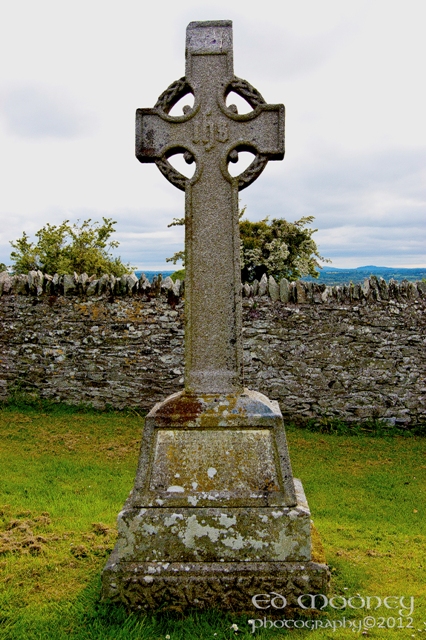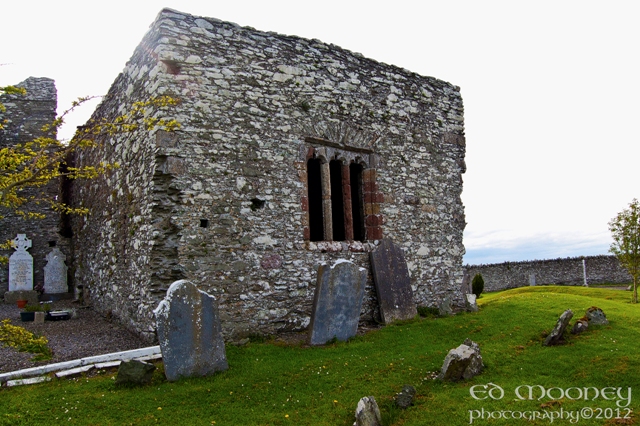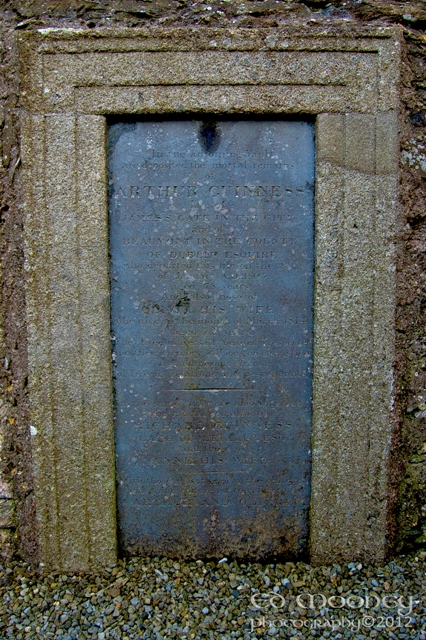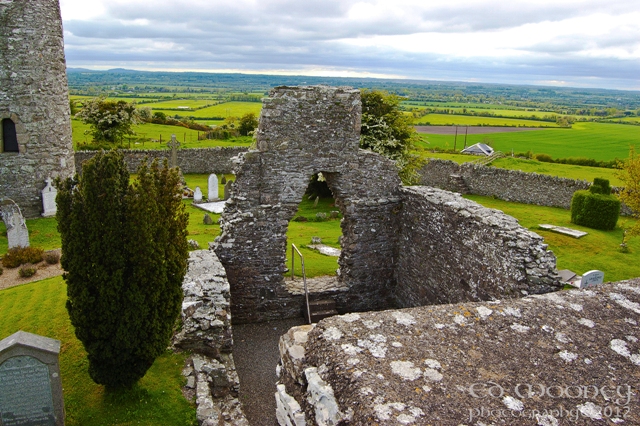After being told about the round tower here at Oughterard by a colleague whom lived in the area, I set of on the way home from work one evening to try and find the site. A couple of wrong turns later and a detour through Newcastle which also had some interesting sites, which I plan to visit soon. I eventually made my way through Ardclogh. Following the road up a hill for about 2 km the road veers off to the right. The main entrance is quite easy to miss as it is located in between two residences which surprisingly I also drove by, not noticing the site until I had driven well past it. I was able to park the car on the verge opposite the entrance. The gate is marked Oughterard Cemetery. When I visited, the gates were locked but access via and old-fashioned turnstile leads to a short trail up the remainder of the hill to the site of a very old graveyard, surrounded by a high wall which also contains the ruins of an old church and the round tower. Some of the information about the great history and archaeology of this great site comes from the guys at Abarta Heritage. Please take a moment and check out the link at the end of this post where you can hear the story for yourself with their free audio guides.
The gates into the graveyard where also locked, but I was able to climb the wall via an ancient stile. The grounds of this site are kept extremely well and the first thing that struck me was the vast amount a slab marked graves, which I have not seen in such abundance anywhere on my various explorations to date.
Oughterard which in Gaelic (Uachtar Ard) translates to (A high place), was associated with an ancient monastery from approx 605AD and was alleged to have been founded by a Saint Briga, whom was the daughter of Congall and whose feast day is held on January 21st. Now this woman is not the same as Saint Brigid of Kildare whom was the daughter of Dubhthach and has a feast day on February 01st. This monastery also had links to the Uí Dúnlainge dynasty whom held the seat of the kings of Leinster during the period of 750 – 1050 AD. They were said to have been the patrons of this monastic settlement. Recent research has established the existing ruined church on the site dates to c. 1350 and not 1609 as previously thought.
The round Tower which dates back to the 8th century is one of five which can be found in County Kildare, is in a good state of repair but appears to have suffered severe damage as only the first 8 – 9metres remain. The round tower is the only remains of an early settlement here and appears to be constructed of mainly limestone. The door which there is no access to unlike the one at Brigids Cathedral in Kildare town stands approx 2.5 meters above ground level.
The monastery and round tower were burned during Viking raids led by Sigtrygg Silkbeard in 995 AD. The site was part of a large estate given as a dowry by Dermott McMurrough on the marriage of his daughter Aoife to Strongbow whom was also known as Richard DeClare, Earl of Pembroke during the Norman invasion of Ireland in 1170. The site next fell into the ownership of Adam deHereford whom passed it on to St. Thomas’s monastery when he died in 1210. For almost several centuries the monastery lands were rented to local tenant farmers until the Dissolution of the Monasteries in Ireland in 1536-41. The church was described as being “in ruins” by 1620 although it is not clear when the church fell into disuse.
The Church ruins are dated anywhere between 1189 and 1350 although the later date is more likely due to a fine example of a barrel-vaulted roof. An adjoining tower has partially come away from the main structure of the church and has been supported by two concrete buttresses to stop any further movement of the tower. Within the church lies the tombed vault of the infamous Arthur Guinness whom set up the Guinness brewery at St. James Gate in Dublin and is father to one of Ireland’s most popular exports. Whilst the first half of the church is in a bad state of ruin, entry into the second part of the church is quite dark. The main window on the east side of the church is still intact but sheds little light into the room. What appears to be a table top style tombstone can be found directly underneath the window. Just inside the roofed area of the church lies the entrance to the falling tower which is surprisingly still accessible for those brave enough for a climb up the winding stone stair case which could be extremely slippy on a wet day.
From the top of the tower you can step directly out onto the barrel-vaulted roof where a fantastic view can be had, (if you’re not faint of heart). From here you can really see a better layout of the graveyard and make out where the vaulted tombs are. A small ruined castle tower stands about 300 meters south-east of the graveyard, which I intend searching for at a later date.
For more of my images, why not visit my Website,or follow me on Facebook, Instagram or Twitter.






















Pingback: Oughaval Church | EdMooneyPhotography
Pingback: St. Kevin’s Kitchen – Glendalough | EdMooneyPhotography
Pingback: The Abbey at St. Mullin’s | EdMooneyPhotography
Pingback: Capturing History Challenge Week 15 | Ed Mooney Photography
Pingback: Oughaval Church | Ed Mooney Photography